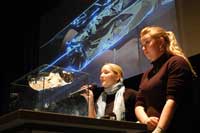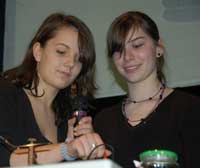Fun physics in school: students perform for students Teach article
Herbi Dreiner and Tobias Strehlau describe how a university physics show inspired a secondary-school teacher and his students to perform their own school physics show. Why not try it in your school?
The inspiration – at university

an aluminium ship which floats
on invisible sulphur hexafluoriden
Image courtesy of Herbi Dreiner
The auditorium of the Amos Comenius Gymnasium in Bonn, Germany, is packed with 400 teenagers. It is completely dark; Lena creates methane-filled soap bubbles, and her partner Stefanie ignites the rising bubbles with a gas flame. The result is a spectacular burning gas cloud, which lights up the whole stage and the beaming faces of the audience. It is the last of 18 exciting experiments that 16 high-school students (aged 15-18) have presented to their fellow students in a 75-minute physics show.
This project was initiated by Werner Urff, physics teacher at the high school, and Herbi Dreiner, a physics professor at the University of Bonn. Every year for the past six years, Dreiner and his second-year university physics students have presented a new ‘Physikshow’ at the universityw1. In these two-hour shows, university students demonstrate and explain funny, fascinating physics experiments to an audience consisting largely of children and teenagers aged 10 and older.
Like most German university physics departments, the Bonn department has a collection of experiments suitable for lecture demonstration: typically large and impressive, they reveal particular physical phenomena. Some of the Physikshow experiments are taken from this collection; others are invented and built by the physics students themselves. Some are large and very spectacular, but special small effects can also be entertaining – for example when combined with music. They all help to convey one message: physics is fun. Fun is also what the university students are there for, since there is no grading or other curricular advantage for them. They enjoy physics and demonstrate their enthusiasm to their audiences with each performance.
The implementation – at school
After one show, Urff and his high-school students thought: “Wouldn’t it be great if we presented a show at our own school?” Dreiner and eight university students, all Physikshow veterans, supported them in the preparation. Two months before the school show, the high-school students – all volunteers – assembled into pairs, each with a university student to help, and chose experiments from the demonstration pool at the university. Of special interest were experiments for which the school does not have the equipment, because it is too expensive or too large to store: this was a great chance to borrow it from the university. These were the experiments they were going to present and explain in their own school show.

demonstrate that a dill pickle will
emit visible light when a standard
alternating current is passed
through it
Image courtesy of Herbi Dreiner
Before the rehearsals began at school, the teenagers visited the university to try out their experiments with the help of their Physikshow mentors. On each of the following four afternoons, the school students and mentors met in the school auditorium to build and arrange the equipment, rehearse the experiments, devise comprehensible explanations of the phenomena and find the best camera angles for the big-screen projection. The camera work was done by the school’s student stage crew, which takes care of lighting and sound for school plays.
Although this was not really enough rehearsal time, the final result was amazing. The school students showed tremendous confidence and – most importantly – had loads of fun. Lena and Stefanie probably embody this the best. At the beginning, they did not seem very motivated or interested. However, during the rehearsals, they emerged as leaders of the group and displayed a great will for perfection in performing their experiments. After the show their opinions had completely changed: “We are so glad that we took part. It is so much fun. Let’s do it again!”
Half of the group were girls, none of whom had been especially interested in school physics before. Our impression from this group of high-school students was that the show was their first opportunity to be creative in physics and thus they were very happy to get more involved in the subject.
Do it yourself
If you want to initiate a project like this, your primary motivation should be getting the message across that physics is extremely enjoyable and entertaining, both for the performing students and for the audience. Though the show demanded a lot of time and work from both the high-school and university students, it was definitely worth it: the high-school students not only learned some physics, but also learned to organise themselves as a team and to perform confidently in front of hundreds of people. Through all of their effort and dedication, this had become their show: they were very enthusiastic and this enthusiasm carried over to their fellow high-school students in the audience.
Perhaps not all schools have the chance to work with a nearby university on such a project. But half the fun is actually finding and building experiments yourself. This requires a lot of preparation time, but is also very rewarding. There are endless ideas for experiments on the Internetw2 and in books – or just play around, for example placing things in a microwave (under supervision) to see what is fun.
Three of our most successful experiments were very cheap:
- The methane soap bubbles described above. We took methane from a gas bottle and hooked it up to a large cone-shaped ‘soap bubble former’ from a toy shop. We dunked this in a standard soap bubble solution and thus made large bubbles. The soap bubbles rise because methane is lighter than air, and this also makes it easier to ignite them. They burn because methane is flammable.
- A 25 kg steel ball pendulum hung from the ceiling. We put a teacher on stage and released the pendulum just in front of her nose. The camera was focused on her frightened face as the ball swung back towards her at high speed. Of course it did not reach her face because of the conservation of energy, but it approached so fast that even the most hardened physicist might lose faith in the fundamental laws of physics.
- Smoke rings. We had a large plywood box, 1.4 m wide and deep, with a circular opening of 40 cm diameter on one side. The opposite side was open and covered with plastic foil. We filled the box with stage smoke and banged the foil back. This released a large stable smoke ring, which floated right across the auditorium. With a spotlight in a dark hall this was a spectacular effect. It also demonstrates that vortices are surprisingly stable.
Safety note:
Ensure that the proposed procedures are in line with commonly adopted risk assessments.
Good experiments are often more a question of presentation than money. Music is also a helpful tool. If money is a problem, though, perhaps the parents and school board could be asked to provide modest financial assistance for materials. After all, such events not only motivate the students but can also attract external visitors and media to a school.
Our success in getting high-school students involved is mirrored in a project at the Gesamtschule Hennef, near Bonn. Six years ago, Ingo Wentz, a physics teacher, started the ‘Physikusse’w3 with a group of his students. They meet weekly and work on different physics projects, such as building demonstration experiments themselves. Once a year they participate in the ‘Freestyle Physics’ competitionw4 at the University of Duisburg, Germany, where high-school students must meet challenges such as building their own hovercraft.
The Physikusse have also planned and performed several physics shows using simple materials, starting with 20-minute performances for parents and fellow students on the school’s open days and also at an open day at the German Physical Society. Wentz himself talks of ‘low-cost physics’. He has also had some success in acquiring more expensive materials: for example, he persuaded a local company to donate liquid nitrogen whenever the group needs it. The Physikusse receive modest financial support from the school board and Wentz gets a slight reduction in his teaching load to allow him to organise the activities.
In summary, a physics performance by students for fellow students is a great way to get children of all ages motivated and attracted to physics. It is rewarding for the audience, the teacher and most of all for the participating students. We would be happy to advise or discuss with people who are thinking of setting up something similar.
Web References
- w1 – More on the Bonn University Physikshow can be found at:
- http://de.arxiv.org/abs/physics/0701344 and
- http://cerncourier.com/cws/article/cern/31198
- w2 – For inspiration for experiments, see: http://physikshow.uni-bonn.de/index.php?job=Versuche
- w3 – For more information about the ‘Physikusse’ project in Hennef, see: www.physikusse.de
- w4 – For more information about Freestyle physics, see: www.freestyle-physics.de
Resources
- Sprott JC (2006) Physics Demonstrations: A Sourcebook for Teachers of Physics. Madison, WI, USA: University of Wisconsin Press
- Part of it can even be read online: http://sprott.physics.wisc.edu/demobook/intro.htm
- Walker J (1975) The Flying Circus of Physics. New York, NY, USA: Wiley
- The US journal ‘The Physics Teacher’ regularly has good experiments. See: http://scitation.aip.org/tpt/
- The UK’s Institute of Physics ‘Physics to Go’ pack contains advice on running a physics event (including a list of recommended 20 physics-based tricks) and can be downloaded here: www.iop.org/activity/outreach/Resources/
- Putting_on_your_own_event/Things_to_do/page_19207.html
Review
In schools and colleges, the fun, showy side of practical work in physics can get buried deeper and deeper under dry theory as students progress up the years. The authors give us encouragement to dust down that apparatus languishing in the physics preparation room or to cajole neighbouring college or university physics departments to come in and ‘show their stuff’. The primary motivation for such a show is the excitement of the demonstrations and conveying enthusiasm for the subject (with any improved appreciation of the concepts involved being a welcome bonus, not to mention a successful event being great public relations for the school physics department!).
In most UK schools, the closest we tend to get to this kind of showmanship is on open evenings, when parents of prospective pupils tour the school. Running a science show, with genuine pupil involvement as demonstrator-explainers, takes this to the next level, with the benefit of a captive audience. The slightly theatrical nature can encourage the participation of girls, too, and anyone too shy to present or explain a demonstration can still be a useful team player by helping with lighting or sound. It could be just the thing to enable your physics students to practise their communication skills in a meaningful way.
Ian Francis, UK





